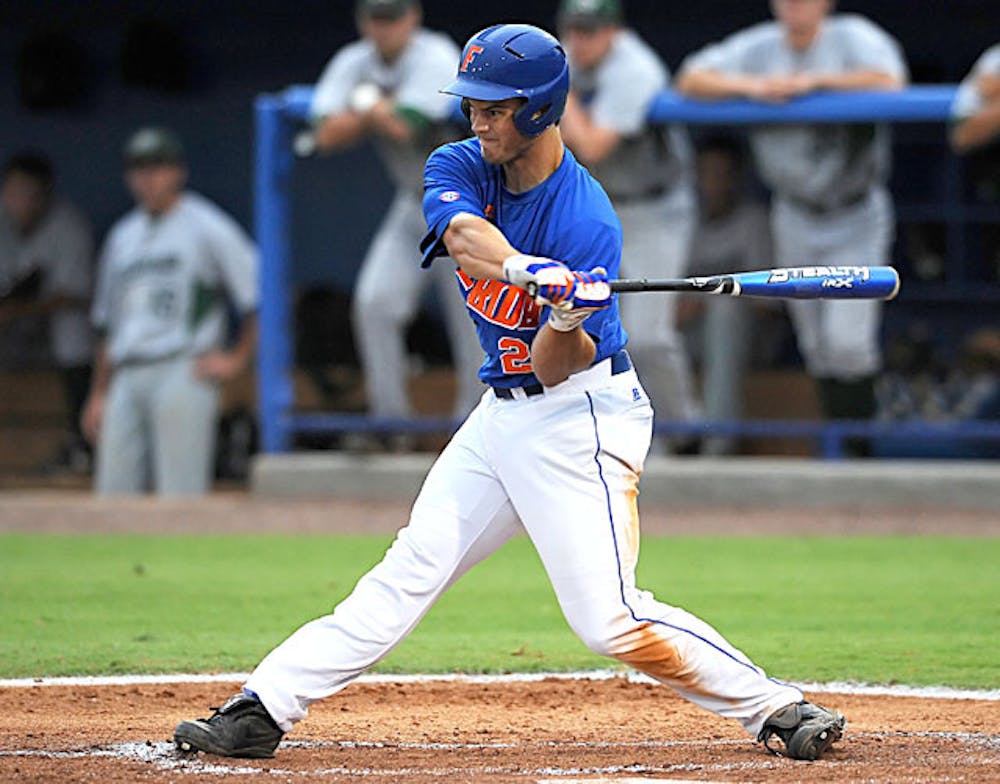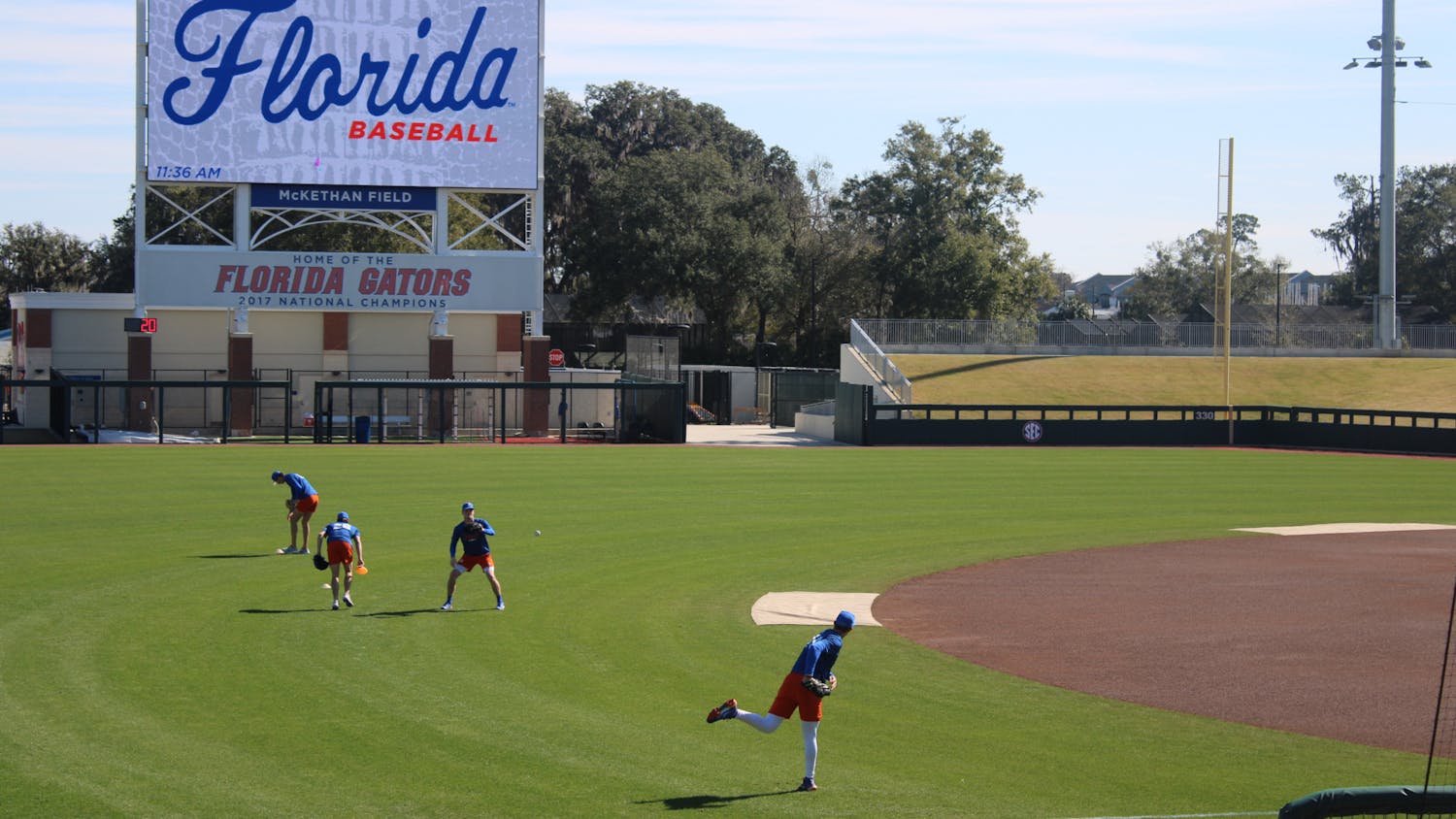Every eye in McKethan Stadium zones in on the aluminum bat — an innocent yet intimidating instrument.
The bat is cocked behind Preston Tucker’s head. It teeters back and forth, ready to unload.
Piiingg
The incoming pitch fires off Tucker’s bat. Outfielders swiftly spin around to see it disappear. Seconds later, Tucker’s victim bounces off an unfamiliar surface.
Ball, meet the concrete of Stadium Road.
Tucker, repeating his routine, hits two more home runs. Bat teeter. Swing. Connect. Goodbye.
Tucker aims for a light pole behind right-center field. He never hits it, but he comes close. Ladies and gentlemen, welcome to the Preston Tucker Showcase. Grab a seat and enjoy the experience.
The Gators are still in the preseason, and assistant coach Craig Bell is grooving pitches down the middle, gift-wrapping batting practice homers. Not that it would make a difference.
Just ask UCF relief pitchers Cory Weech, D.J. Hicks and Matt Goodyear. On April 8, Tucker crushed home runs off all three relievers — two for grand slams — and finished the game with 11 RBIs.
Tucker was Florida’s most productive hitter last season, leading the team in batting average, home runs and RBIs. He even set a school record by driving in 85 runs.
And that was just his first year in college.
“To do what he did is just remarkable,” UF coach Kevin O’Sullivan said. “There’s been a lot of really, really good players to have come through this program, and to break the RBI record, just being a freshman, is unbelievable.”
When predicting the batting order for his teams in the preseason, O’Sullivan said he normally only knows which players to put at the bottom of the lineup. But, for at least the next two years due to MLB draft rules, he has UF’s No. 3 hitter penciled in.
Getting noticed
By Tucker’s standards, his freshman season was actually pedestrian. As a junior at Tampa Plant High, Tucker broke a school record with 51 RBIs in 25 games.
But few college coaches were interested in him. After his record-breaking season, Tucker only received a scholarship offer from Duke.
Most teams were scared of Tucker’s weird swing, Plant coach Dennis Braun said.
Tucker was a dead-pull hitter, always trying to muscle balls into right field. He also took a hard step toward the mound before swinging, giving him lots of power but making him look foolish against slow changeups.
Tucker’s form was ugly, and it worked.
“The smartest thing I ever did was realize we need to leave this kid alone a little bit,” Braun said.
Tucker’s awkward swing wasn’t as easy for scouts to overlook — until one week in June 2007.
Tucker was a last-minute replacement for an injured player at the USA Baseball Tournament of Stars, a showcase of 142 coveted high school prospects.
During warm-ups, the batters’ box became Tucker’s stage. The balls he launched out of the park did not travel on a line like they do for most prep stars. Instead, the battered balls soared high and seemed to never stop, just like they do in the Major League.
The same week, Braun coached the All-American Prospects 16 at the USA Baseball 16U Championships in Jupiter.
“I came back to the hotel and I had 35 messages on my phone,” he said, “and I knew Preston tore it up there. Everybody in the nation wanted him.”
The scouting report on Tucker changed practically overnight. Instead of a batter with an undisciplined swing, he was now a natural hitter.
Scouts also gawked at Tucker’s strength, embodied by his “Popeye” forearms.
Tucker, who now weighs about 220 pounds, started lifting weights at Plant when he was 15 years old.
“I wasn’t the biggest kid in the world,” Tucker said. “I was probably about 165 pounds after my sophomore year, and there was a lot of balls I’d fly out to the (warning) track.”
That offseason, the baseball team worked out with University of Tampa strength coach Eric Hall, who has trained two Division-II national championship baseball teams. Tucker was the strongest, fastest kid in the gym, Hall said.
He also worked harder than anybody else Hall trained, including the college players.
When he finished his workouts with Hall around 7 p.m., Tucker drove to the YMCA and lifted more weights.
Tucker also asked Hall for resistance-band exercises for his “off days.”
“He knew he was going to the next level,” Hall said. “He knew what it was going to take for him to get there. He was, by far, stronger (and) faster. He was doing a lot more things than the other kids were.”
Tucker added 15 pounds of muscle this offseason, and his draft stock rises as he continues to grow.
Draft Dilemma
After graduating from Plant in 2008, Tucker was overlooked by all 30 MLB teams during the 50 rounds of that year’s draft.
But scouts changed their minds after watching Tucker become Florida’s most feared hitter last season.
“If Tucker were in this year’s class, he would be a top-10 pick,” Baseball America’s Aaron Fitt said. “There are no power bats in this class that can compare with him.”
MLB scouts compare Tucker to former Vanderbilt third basemen Pedro Alvarez, Fitt said.
Alvarez, who was the second pick of the 2008 draft, signed a four-year contract with the Pittsburgh Pirates that guarantees him about $6.3 million.
But Tucker won’t be signing a multimillion-dollar contract after this season. He isn’t allowed to.
MLB Draft rules stipulate a player cannot leave college until he turns 21 or has finished his junior season.
The rule is similar to those in the NBA and NFL with a few exceptions.
While there is an age limit on players turning pro from college, a high school player can enter MLB upon graduation. And so can a junior college player, regardless of his age.
Bryce Harper, the 17-year-old who Sports Illustrated dubbed “Baseball’s LeBron,” will be eligible for the 2010 MLB Draft after receiving his GED diploma and enrolling early at the College of Southern Nevada this season.
Meanwhile, Tucker, who will turn 20 in July, cannot enter the MLB Draft until 2011.
From now until then, his stock could fall.
A player’s value in the eyes of scouts is fickle as illustrated by the story of former Gators third baseman Brandon McArthur
The Minnesota Twins drafted McArthur out of Seffner Armwood High in the third round in 2003, but he rejected a contract offer when his parents urged him to enroll at UF, saying he was not mature enough to play pro ball.
McArthur suffered two season-ending injuries at Florida, extending his stay in Gainesville to six years.
He was sucker punched outside the Grog House in 2003, almost costing him his life. Then he tore the ulnar collateral ligament in his right elbow on opening night in 2007. The next year, he tore the ACL in his right knee, sidelining him for two weeks.
McArthur, who now plays for the Joliet Jackhammers in the independent Northern League and still hopes to play in MLB, was never drafted after 2003.
“The knee injuries had piled so high that it was just highly unlikely that I would get a shot,” McArthur said.
Tucker, on the other hand, remained injury-free his first year on campus. But even if he stays healthy for the next two or three years, Tucker’s draft value could fall.
If opposing teams choose to pitch around him, as O’Sullivan expects, Tucker’s power numbers could decrease, dropping him out of the first round. But Tucker said he does not worry about projections.
“The draft is always a toss-up,” he said.
Instead, Tucker sticks to his routine.
It’s what earned him a scholarship. It’s what lets him aim for light poles behind the outfield. It’s what pro scouts will have to settle for until they are allowed to draft him.
Swing. Connect. Goodbye.






